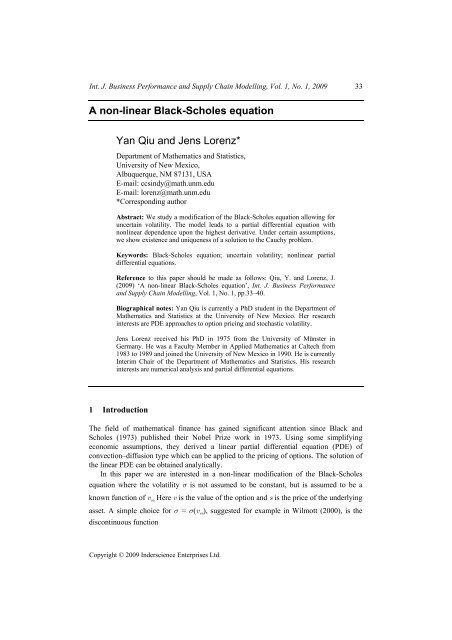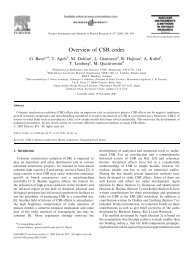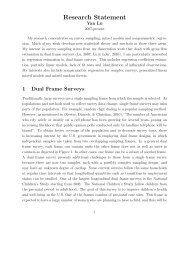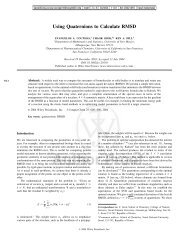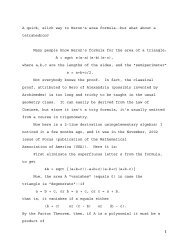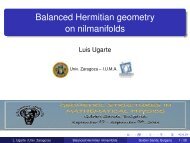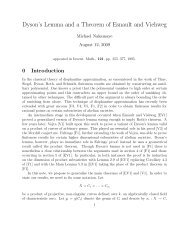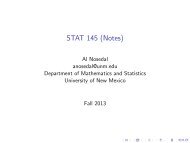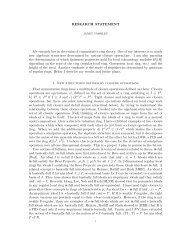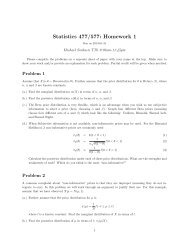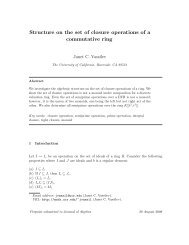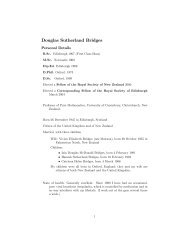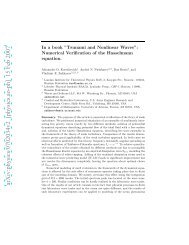A nonlinear Black--Scholes equation - Department of Mathematics ...
A nonlinear Black--Scholes equation - Department of Mathematics ...
A nonlinear Black--Scholes equation - Department of Mathematics ...
You also want an ePaper? Increase the reach of your titles
YUMPU automatically turns print PDFs into web optimized ePapers that Google loves.
36 Y. Qiu and J. LorenzDenote the right–hand side in formula (2) by v 0 (s).If one uses the transformation⎛ 1 2 ⎞rT ( −t)τ = T − t, x = ln( s) + ⎜r − σ ⎟( T − t) , w( x, τ)= e v s,t⎝ 2 ⎠the <strong>equation</strong> (1) transforms to the heat <strong>equation</strong>,w1= σ 2 wτ xx2and the end-condition (2) transforms to the initial condition:x( 0 ) = ( ) = ( ) = ( ) = ( )w x, v s, T v s v e w x .The problem has the explicit solution0 0 0( )or2 + ∞ 21 −( x−y)2στw( x,τ ) =∫e w−( y)dy0∞ 22πσ τ22( )+ − ⎜ln() s + ⎜r − ⎟( T −t ) −y ⎟/2 ( T −t)−rT−t∞σσ1⎝ ⎝ 2 ⎠ ⎠yv( s, t)= e∫e v ( e ) dy.0−∞ 22πσT − t( )⎛⎛1⎞2⎞3 Modified <strong>Black</strong>-<strong>Scholes</strong> model with variable volatilityWe can modify the assumptions leading to the <strong>Black</strong>-<strong>Scholes</strong> model in different waysregarding different parameters. Here, we focus on the constant volatility assumption. Thevolatility is not known in advance as a constant but is an uncertain stochastic variable.There are two traditional ways to measure volatility: implied or historical.Another possibility is to assume a known range for the volatility σ:− +0< σ ≤σ ≤ σwhere σ + and σ – are (estimates for) the maximal and minimal values <strong>of</strong> σ. We then have⎧11 2 2 ⎪σ sv =ss ⎨22 ⎪⎪ 1⎩2+( σ )−( σ )2sv 2ssmin− +2σ ≤σ≤σ2svssif vif vssss
A non-linear <strong>Black</strong>-<strong>Scholes</strong> <strong>equation</strong> 37σd( v )ss⎧ +⎪σif v 0ss(3)As outlined in the previous section, under delta hedging, Δ = v s we haved ⎛⎞= ⎜ v 1π + σ 2 ⎟ .ts 2 v ssdt⎝ 2 ⎠Assume the minimum return on the portfolio with volatility σ varying over the rangeσ – ≤ σ ≤ σ + equals the risk-free return rπ dt.We then obtain⎛ 1 2 2 ⎞⎜v + σ ( v ) s v ⎟dt = rπdt = r( v −sv t d ss ss s)dt⎝ 2⎠with σ d (v ss ) given by (3). One obtains the non-linear PDE1v + rsv + ( ) − =t s σ 2 v s 2 v rv 0d ss ss2(4)In this case, because <strong>of</strong> the variability <strong>of</strong> σ = σ d (v ss ), the transformation⎛ 1 ⎞x = ln s + r − σ 2 T −t⎝ 2 ⎠( ) ⎜ ⎟( )applied in previous section is not useful since it depends via σ on the solution v. Instead,we apply the much simpler transformationleading torτ( ) ( )τ = T − t, x = s, u x, τ = e v s,t1u = σ 2 ( u ) x 2 u + rxu , x >0τ d xx xx x2( 0) = v( s T)u x, , .(5)4 Existence and uniqueness analysisThe essential mathematical difficulty <strong>of</strong> (4) lies in the non-linear term ( u ) u .address this essential difficulty, we consider an <strong>equation</strong> <strong>of</strong> the form( )σ 2d xx xxu = G u u (6)t xx xxwhere G : R → (0, ∞) is a given smooth positive function.To
38 Y. Qiu and J. LorenzThe function σ d in (4) is not smooth, <strong>of</strong> course, but we can approximate σ d by asmooth function like1 + − 1 + − ⎛ ⎞= + − − tanh 1σ σ σ σ σ ⎜ uεxx ⎟2 2,⎝ε⎠( uxx) ( ) ( )ε >0Figure 1The graphs <strong>of</strong> σ d (left) and σ ε (right) for σ + = 0.3, σ – = 0.2 and ε = 0.3 (see onlineversion for colours)σ (u )σ d xx ε(u xx)0.30.3σ d0.25σ ε0.250.20.20.15−10 −5 0 5 10u xx0.15−10 −5 0 5 10u xxDifferentiate <strong>equation</strong> (6) twice with respect to x and set w = u xx to obtain= ( ) + ′( )where ( ) ( ) ′( )w h w w h w w 2 (7)t xx xh w = G w + G w w . It will be convenient to consider the slightly moregeneral <strong>equation</strong>( ) ( ) ( ) ( )w = h w w + g w, w , w x, 0 = f x ,(8)t xx xwhere h(w), g(w, w x ) and f(x) are C ∞ functions <strong>of</strong> their arguments. To concentrate on theessential mathematical difficulty, the non-linear volatility coefficient, we assume theinitial function f(x) to be 1-periodic; we then seek a solution w(x, t), <strong>of</strong> (8) which is1-periodic in x. Other boundary conditions will be considered in future work.Theorem 4.1Consider the 1-periodic initial value problem (8) under the aboveassumptions. In addition, assume that h(w) ≥ k > 0 for all real w andthat h and g and all their derivatives are bounded functions. Then thereis a unique C ∞ solution w(x, t) which is 1-periodic in x. The solutionsexists for 0 ≤ t < ∞.
A non-linear <strong>Black</strong>-<strong>Scholes</strong> <strong>equation</strong> 39Remark: If h or g or their derivatives are unbounded, one can use a cut-<strong>of</strong>f argument andreplace h or g by functions h % or %g which satisfy the conditions <strong>of</strong> the theorem. For theoriginal problem, one then obtains a result which is local in time.To prove the existence part <strong>of</strong> the theorem, we define a sequence <strong>of</strong> functions w n (x, t)via the iteration( ) ( ) ( ) ( )n+ 1 n n+ 1 n n n+1t xx xw = h w w + g w , w , w x, 0 = f x , n = 0,1,2, K (9)starting with w 0 (x, t) ≡ f(x). Since the problem (9) is linear parabolic, there is nodifficulty in establishing existence, uniqueness and smoothness <strong>of</strong> the functionsw n (x, t) ≡ w n (x + 1, t) for 0 ≤ t < ∞.It can then be shown and this is the main mathematical difficulty, that the functionsw n (x, t) are ‘uniformly’ smooth in any finite time interval. More precisely, for any fixed0 < T < ∞, all derivatives are bounded independently <strong>of</strong> the iteration index n:p+q∂ nsup max max w x, t C p, q,Tx t T p qn 0≤ ≤ ∂x∂t( ) ≤ ( )
40 Y. Qiu and J. Lorenz3 The case <strong>of</strong> a non-smooth volatility σ d (μ xx ) can also be treated as a free boundaryvalue problem where lines (x(t), t) with μ xx (x(t), t) = 0 will be determined as freeboundaries.References<strong>Black</strong>, F. and <strong>Scholes</strong>, M. (1973) ‘The pricing <strong>of</strong> options and corporate liabilities’, J. PoliticalEconomics, Vol. 81, pp.637–654.Kreiss, H-O. and Lorenz, J. (1989) Initial-boundary Value Problems and the Navier-stokesEquations, Academic Press, Boston.Wilmott, P. (2000) Paul Wilmott on Quantitative Finance Volume One and Volume Two,John Wiley & Sons Ltd, Chichester.


